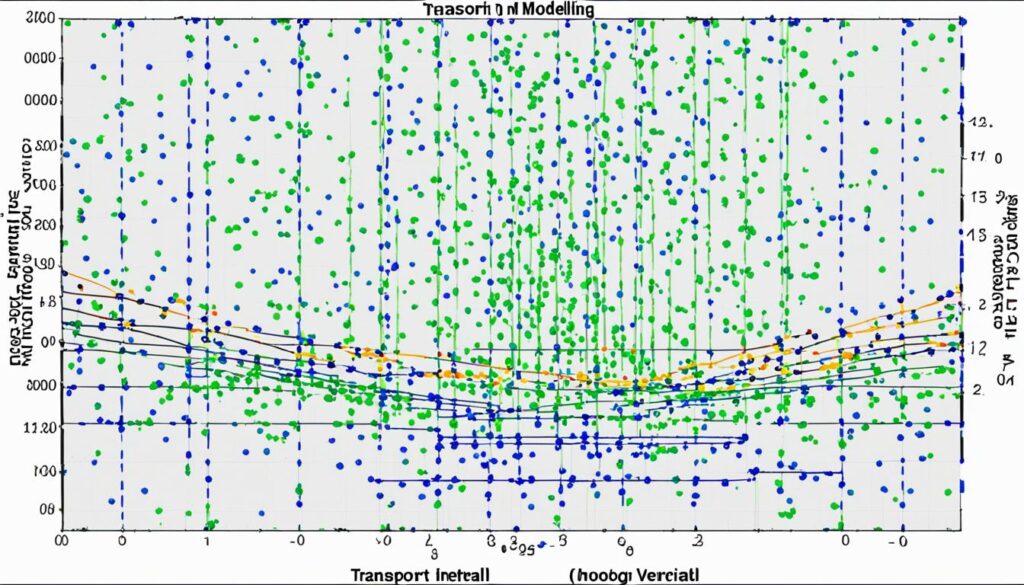Welcome to our informative article on delay modeling in Verilog, where we will explore the essentials of both transport and inertial delay modeling. As digital design simulations play a crucial role in ensuring the accuracy and efficiency of complex systems, understanding the principles and techniques involved in delay modeling is essential.
In this section, we will delve into the intricacies of delay modeling, including transport delay and inertial delay. By understanding these concepts, you will be able to enhance the precision of your digital design simulations and optimize their efficiency. Let’s begin by examining the significance of delay modeling in Verilog and its impact on digital design simulations.
Delay modeling is a fundamental aspect of Verilog that enables accurate simulations of digital designs. It allows designers to capture the behavior of various components and functionalities within a system by accounting for delays introduced by signal propagation and circuitry. By representing these delays in Verilog models, designers can obtain a realistic representation of the system’s behavior and simulate its performance under different scenarios.
Within delay modeling, two key types are commonly used: transport delay and inertial delay. Transport delay refers to the propagation delay of a signal from one point to another, ensuring that the timing relationship between different elements is accurately modeled. On the other hand, inertial delay characterizes the response of digital circuits to input signals and events, playing a crucial role in event-driven simulations.
Throughout this article, we will explore the principles and techniques involved in both transport and inertial delay modeling. Additionally, we will discuss the differences between these two approaches and provide insights into optimizing delay modeling techniques to enhance simulation efficiency.
By the end of this article, you will have a comprehensive understanding of delay modeling in Verilog, enabling you to effectively simulate and analyze the behavior of complex digital systems.
Table of Contents
Introduction to Delay Modeling
Before we dive into the specifics of Verilog delay modeling, let’s first understand the basics. Delay modeling plays a crucial role in Verilog and has a significant impact on digital design simulations. By accurately modeling delays, we can analyze and predict the behavior of digital systems.
In Verilog, delay modeling involves capturing the time taken for signals to propagate through logic gates and interconnects. It allows us to simulate and evaluate the performance of digital circuits under different conditions, ensuring the design meets the desired specifications.
Delay modeling is essential in digital design simulations as it enables us to identify potential timing issues, assess circuit performance, and validate the functionality of our designs before physical implementation. By simulating delays, we can analyze critical paths, evaluate setup and hold times, and optimize the overall performance of our designs.
To offer a comprehensive understanding of Verilog delay modeling, we will explore both transport and inertial delay modeling techniques in subsequent sections. These techniques enhance the accuracy and efficiency of digital design simulations, enabling designers to make informed decisions and achieve desirable results.
Verilog Delay Modeling in Digital Design Simulations
Before we proceed further, let’s take a moment to visualize the importance of delay modeling in digital design simulations. The image below illustrates the impact of accurately modeling delays on the performance of our designs:
| Delay Modeling | Benefits |
|---|---|
| Transport Delay Modeling | • Enables accurate representation of signal propagation time • Helps identify critical paths and potential timing issues • Improves simulation accuracy |
| Inertial Delay Modeling | • Captures complex signal behavior, including glitches and metastability • Enables event-driven simulations • Provides insights into circuit performance under various conditions |
Transport Delay Modeling in Verilog
When it comes to Verilog modeling, accurate simulations are of utmost importance. To achieve this accuracy, it is essential to understand and implement transport delay modeling in your digital designs. This section will explore the principles and techniques involved in Verilog transport delay modeling, ensuring that your simulations are precise and reliable.
Transport delay modeling in Verilog focuses on capturing the time delay that occurs between the input and output of a logic gate. This delay is crucial for accurately representing the propagation of signals in digital circuits. By incorporating transport delay modeling, you can simulate the effects of real-world timing constraints, such as wire delays and gate delays, in your digital designs.
To effectively model transport delays in Verilog, we utilize delay value specifications. These specifications include the delay identifier, signal names, and delay values associated with the input and output pins of a logic gate. By assigning appropriate delay values, you can accurately represent the timing behavior of your digital system.
One common technique used in transport delay modeling is specifying the delay values using constants or variables. This allows for flexibility in adjusting the timing behavior during simulations, ensuring accurate representation of the system’s performance.
Moreover, it is important to consider the delay modeling of nets and wires in your Verilog design. Nets and wires play a vital role in connecting various components and propagating signals throughout the circuit. Properly modeling these interconnects with the appropriate transport delay values is crucial for achieving accurate simulation results.
To illustrate the concepts of Verilog transport delay modeling, let’s consider an example implementation of a combinational logic circuit. In the table below, we showcase the delay values associated with the input and output pins of the logic gate:
| Logic Gate | Input Delay(s) | Output Delay(s) |
|---|---|---|
| AND Gate | 0.5 | 0.8 |
| OR Gate | 0.3 | 0.6 |
| NOT Gate | 0.2 | 0.4 |
By incorporating these delay values into the Verilog code, you can accurately simulate the timing behavior of the combinational logic circuit. This level of accuracy is crucial for identifying potential timing issues and ensuring the proper functionality of your digital designs.
Now that we have explored the principles and techniques of transport delay modeling in Verilog, we can move on to the next section, which focuses on inertial delay modeling. The knowledge gained from both sections will provide a comprehensive understanding of delay modeling in Verilog and enable you to make informed decisions when designing and simulating digital circuits.
Inertial Delay Modeling in Verilog
Inertial delay modeling plays a crucial role in capturing the intricate behavior of complex digital systems. It is a fundamental concept in Verilog that enables accurate event-driven simulations. In this section, we will explore the intricacies of inertial delay modeling in Verilog and highlight its significance in event-driven simulations.
When modeling digital circuits, we often encounter scenarios where certain input changes fail to have an immediate impact on the output. Instead, there is a delay before the change propagates through the circuit and affects subsequent components. Inertial delay modeling allows us to accurately capture this behavior by incorporating delays that consider the duration and timing of input transitions.
In Verilog, we can model inertial delay using the “inertial” keyword along with a specified delay value. The inertial delay model considers both the duration and timing of input transitions, ensuring that only certain input changes result in output transitions. This helps in simulating the behavior of real-world electronic components, where noise, glitches, and other transient effects may not trigger changes in the output.
By accurately representing the behavior of digital systems, inertial delay modeling enables us to perform event-driven simulations. This type of simulation focuses on the occurrence of specific events and their effects on the system. Events can be triggered by changes in input values, clock edges, or other specified conditions. Inertial delay modeling allows for precise event-driven simulations by ensuring that changes propagate through the circuit in a realistic and predictable manner.
Let’s consider an example to illustrate the concept of inertial delay modeling. Suppose we have a digital circuit with a flip-flop that changes its output based on the rising edge of a clock signal. Using inertial delay modeling, we can accurately simulate the behavior of the flip-flop by considering the delays in input transitions and the specified clock edge condition. This enables us to observe the correct output changes in response to specific input signals.
Advantages of Inertial Delay Modeling
The utilization of inertial delay modeling in Verilog simulations offers several advantages:
- Accurate portrayal of real-world circuit behavior: By incorporating the timing and duration of input transitions, inertial delay modeling enables simulations that closely mimic the behavior of actual electronic components.
- Predictable event-driven simulations: With inertial delay modeling, event-driven simulations produce reliable and predictable results, allowing us to analyze system behavior under specific conditions.
- Improved design validation: Inertial delay modeling enhances the validation of digital circuit designs by ensuring that changes propagate through the circuit accurately, helping identify potential issues or unexpected behavior.
Next, we will compare and contrast the differences between transport and inertial delay modeling, providing insights into when to employ each approach for different design scenarios.
Differences Between Transport and Inertial Delay Modeling
When it comes to delay modeling in Verilog, understanding the differences between transport and inertial delay is essential. While both approaches are integral to Verilog modeling, they possess distinct characteristics that can impact the accuracy and efficiency of your digital design simulations.
Transport Delay Modeling
Transport delay modeling in Verilog focuses on the propagation delay of signals throughout a circuit. It accurately represents the time delay between the input signal change and the corresponding change in the output signal. This approach is particularly suitable for modeling combinational circuits and simulating real-time behavior.
Inertial Delay Modeling
In contrast, inertial delay modeling in Verilog takes into account the concept of sensitivity and thresholds. It simulates the behavior of sequential circuits by considering events that trigger a change in the output signal. Inertial delay modeling is especially useful for capturing complex timing relationships and accurately representing the response of sequential circuits.
Now, let’s compare and contrast the differences between transport and inertial delay modeling in the table below:
| Transport Delay Modeling | Inertial Delay Modeling |
|---|---|
| Suitable for modeling combinational circuits | Ideal for representing sequential circuits |
| Precisely captures propagation delay | Accounts for sensitivity and thresholds |
| Can accurately simulate real-time behavior | Provides a detailed representation of timing relationships |
As you can see, both transport and inertial delay modeling approaches have their strengths and applications. Consider the nature of your digital design and the specific behavior you want to capture to determine which approach will be most suitable for your simulations.

Techniques for Optimizing Delay Modeling in Verilog
Improving simulation efficiency is crucial in digital design, and optimizing delay modeling techniques can significantly contribute to this goal. In this section, we will explore various strategies and techniques that can be employed to enhance Verilog delay modeling, improving simulation speed and accuracy.
1. Delay Scaling
Delay scaling is a technique that involves adjusting the delays in a circuit to optimize simulation efficiency. By carefully analyzing the design and identifying critical paths, delay scaling can be used to reduce the overall circuit delays, leading to faster simulations without compromising accuracy.
2. Event Optimization
Event optimization focuses on reducing the number of events that need to be simulated, thereby improving simulation efficiency. This technique involves eliminating redundant events and optimizing event scheduling to minimize simulation time and resource usage.
3. Model Abstraction
Model abstraction involves simplifying complex modules or subsystems within a design to reduce simulation time and enhance efficiency. By replacing detailed and time-consuming models with more abstract representations, simulations can be accelerated without significantly impacting accuracy.
4. Parameter Tuning
Verilog allows for the tuning of various parameters such as time steps and simulation granularity. By fine-tuning these parameters based on the specific design requirements, simulation efficiency can be optimized. It is important to strike a balance between accuracy and efficiency when adjusting simulation parameters.
5. Parallel Simulation
Parallel simulation involves distributing the simulation workload across multiple cores or processors, allowing for faster and more efficient simulations. This technique can significantly reduce simulation time, especially for large and complex designs, by utilizing the processing power of multiple computing resources.
By implementing these optimization techniques, Verilog delay modeling and simulation efficiency can be greatly enhanced, enabling designers to achieve faster and more accurate digital design simulations.

Conclusion
In conclusion, delay modeling in Verilog, encompassing both transport and inertial delay, plays a critical role in achieving accurate and efficient digital design simulations. By understanding the principles and techniques involved in these modeling approaches, designers can ensure precise representations of system behavior.
The importance of transport delay modeling lies in accurately reflecting the physical characteristics and timing of signal propagation in digital designs. This enables precise timing analysis and verification, allowing designers to identify potential timing violations and optimize their designs accordingly.
On the other hand, inertial delay modeling captures the complex behavior of digital systems and ensures event-driven simulations. By accurately representing the transient response of signals, inertial delay modeling enables designers to effectively analyze and optimize critical paths, improving overall system performance.
Furthermore, by optimizing delay modeling techniques, designers can enhance the efficiency of digital design simulations. Techniques such as lookup tables, gate-level delay modeling, and hierarchical modeling can significantly improve simulation speed and accuracy, enabling designers to meet tight project deadlines.

